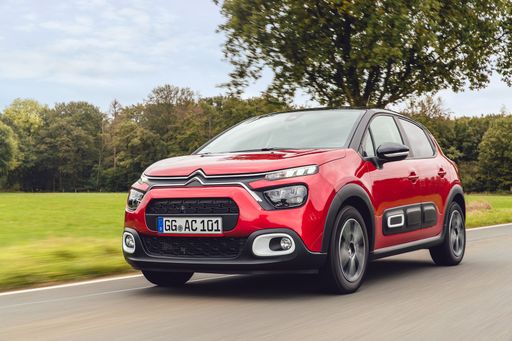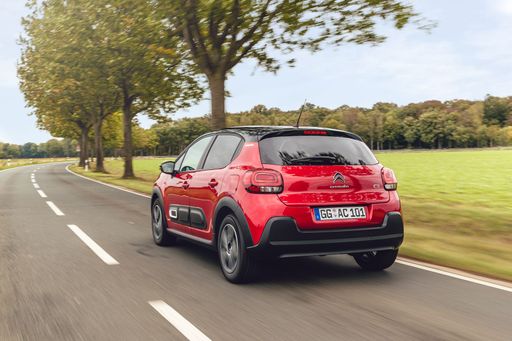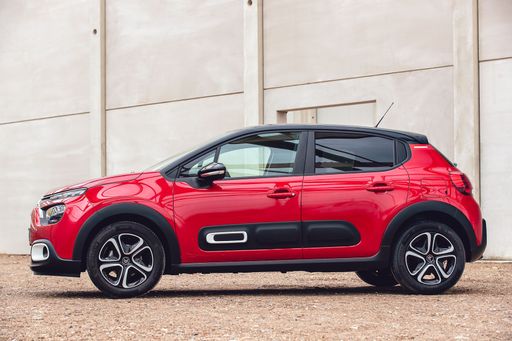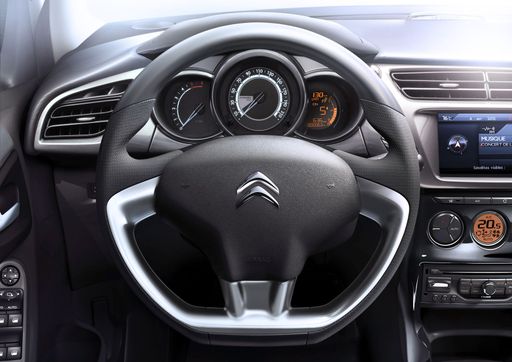Citroen C3 VS Renault Trafic Bus – Specs, Efficiency & Price Comparison
Which model is the better choice – the Citroen C3 or the Renault Trafic Bus? We compare performance (113 HP vs 150 HP), boot capacity (310 L vs ), efficiency (17.10 kWh5.50 L vs 6.80 L), and of course, the price (13700 £ vs 38200 £).
Find out now which car fits your needs better!
The Citroen C3 (SUV) is powered by a Petrol, Electric or Petrol MHEV engine and comes with a Manuel or Automatic transmission. In comparison, the Renault Trafic Bus (Bus) features a Diesel engine and a Manuel gearbox.
When it comes to boot capacity, the Citroen C3 offers 310 L, while the Renault Trafic Bus provides – depending on what matters most to you. If you’re looking for more power, you’ll need to decide whether the 113 HP of the Citroen C3 or the 150 HP of the Renault Trafic Bus suits your needs better.
There are also differences in efficiency: 17.10 kWh5.50 L vs 6.80 L. In terms of price, the Citroen C3 starts at 13700 £, while the Renault Trafic Bus is available from 38200 £.
Compare all the key specs now and find out which model fits your lifestyle best!
Citroen C3
The Citroën C3 exudes a quirky charm with its distinctive design and bold colour options, making it stand out in the crowded hatchback market. Its interior is crafted with comfort in mind, offering plush seating and a host of modern technology features to enhance the driving experience. The C3's compact size makes it an ideal choice for urban commuting, effortlessly navigating through city streets while maintaining a sense of style and practicality.
details @ media.stellantis.com
@ media.stellantis.com
 @ media.stellantis.com
@ media.stellantis.com
 @ media.stellantis.com
@ media.stellantis.com
 @ media.stellantis.com
@ media.stellantis.com
Renault Trafic Bus
The Renault Trafic Bus is a versatile and spacious option for those needing to transport multiple passengers comfortably. With its modern design and practical features, it is well-suited for both business and leisure purposes. Its efficient engine and smooth handling make it a reliable choice for long journeys.
details

|
|
|
|
|
Costs and Consumption |
|
|---|---|
|
Price
13700 - 23800 £
|
Price
38200 - 51100 £
|
|
Consumption L/100km
5.5 - 5.6 L
|
Consumption L/100km
6.8 - 7.2 L
|
|
Consumption kWh/100km
17.1 - 17.4 kWh
|
Consumption kWh/100km
-
|
|
Electric Range
323 - 326 km
|
Electric Range
-
|
|
Battery Capacity
-
|
Battery Capacity
-
|
|
co2
0 - 126 g/km
|
co2
179 - 188 g/km
|
|
Fuel tank capacity
44 L
|
Fuel tank capacity
80 L
|
Dimensions and Body |
|
|---|---|
|
Body Type
SUV
|
Body Type
Bus
|
|
Seats
2 - 5
|
Seats
8 - 9
|
|
Doors
5
|
Doors
4
|
|
Curb weight
1226 - 1518 kg
|
Curb weight
2031 - 2321 kg
|
|
Trunk capacity
310 L
|
Trunk capacity
-
|
|
Length
4015 mm
|
Length
5080 - 5480 mm
|
|
Width
1755 mm
|
Width
1956 mm
|
|
Height
1567 mm
|
Height
1973 - 1974 mm
|
|
Payload
227 - 491 kg
|
Payload
749 - 982 kg
|
Engine and Performance |
|
|---|---|
|
Engine Type
Petrol, Electric, Petrol MHEV
|
Engine Type
Diesel
|
|
Transmission
Manuel, Automatic
|
Transmission
Manuel
|
|
Transmission Detail
Schaltgetriebe, Automat. Schaltgetriebe (Doppelkupplung)
|
Transmission Detail
Schaltgetriebe
|
|
Drive Type
Front-Wheel Drive
|
Drive Type
Front-Wheel Drive
|
|
Power HP
101 - 113 HP
|
Power HP
110 - 150 HP
|
|
Acceleration 0-100km/h
9.9 - 11 s
|
Acceleration 0-100km/h
13.6 - 16.5 s
|
|
Max Speed
132 - 183 km/h
|
Max Speed
161 - 174 km/h
|
|
Torque
120 - 205 Nm
|
Torque
300 - 350 Nm
|
|
Number of Cylinders
3
|
Number of Cylinders
4
|
|
Power kW
74 - 83 kW
|
Power kW
81 - 110 kW
|
|
Engine capacity
1199 cm3
|
Engine capacity
1997 cm3
|
General |
|
|---|---|
|
Model Year
2024 - 2025
|
Model Year
2023 - 2024
|
|
CO2 Efficiency Class
D, A
|
CO2 Efficiency Class
G
|
|
Brand
Citroen
|
Brand
Renault
|
Citroen C3
Introduction to the Citroen C3
The Citroen C3 has long been a staple in the compact SUV segment, combining style, efficiency, and innovation. The latest iteration holds to this tradition while incorporating advancements that truly set it apart from its competitors. In this article, we delve into the technical details and explore the innovations that make the Citroen C3 an appealing choice for modern drivers.
Efficiency Meets Performance
The Citroen C3 offers a range of powertrains tailored to meet diverse customer needs. With petrol and electric options available, the C3 provides either a sleek manual or a responsive automatic gearbox. The petrol variant, powered by a three-cylinder engine, delivers an impressive output of 101 PS, achieving a consumption rate of just 5.6 L/100km. On the other hand, the fully electric e-C3 provides an output of 113 PS and an outstanding efficiency of between 17.1 and 17.4 kWh/100km, with a maximum electric range stretching from 320 to 326 km.
Design and Comfort
Citreon's focus on comfort is evident in the C3's spacious interior design, which accommodates five passengers. The SUV's dimensions — 4,015 mm in length, 1,755 mm in width, and 1,567 mm in height — combine in a way that gives ample room without compromising manoeuvrability. Furthermore, the Citroen C3 boasts a 310-litre boot, ensuring plenty of space for travel luggage or shopping.
Driving Dynamics and Safety
Front-wheel drive and a choice of manual or automatic gearboxes ensure a smooth and adaptable driving experience. The C3 offers a range of advanced safety features and driver assistance systems, cementing its reputation as a car that prioritises the safety of its passengers. Whether navigating city streets or cruising the open road, the Citroen C3's robust design provides assurance to all on board.
Technologically Advanced
Inside, the Citroen C3 presents a suite of modern technologies that enhance every journey. The vehicle's infotainment system is intuitive and easy to operate, featuring integration with smartphones to keep drivers connected. The built-in efficiency monitoring systems also provide real-time feedback, empowering drivers to maintain optimal energy conservation.
The Final Verdict
From its efficient engines to its innovative in-car technology and comfort-driven design, the Citroen C3 stands as an embodiment of modern automotive evolution. With prices starting from €14,990 and reaching up to €27,800, it offers competitive value and versatility for various budgets. In the 2024 model year, the Citroen C3 continues to inspire with its blend of economy, performance, and distinctive style, truly appealing to the demands of today's drivers.
Renault Trafic Bus
A Glimpse into the Renault Trafic Bus: An Icon of Versatility and Innovation
Amongst the plethora of vans designed for both business and leisure, the Renault Trafic Bus stands out as an exemplar of functionality, innovation, and style. Let's delve into what makes the Renault Trafic Bus a popular choice in the UK and across Europe, particularly focusing on its technical specifications and state-of-the-art features.
Performance Dynamics: Power Under the Hood
The Renault Trafic Bus, a staple in Renault's fleet, is driven by a robust diesel engine configuration with power outputs ranging from 110 PS to a formidable 170 PS. The diesel engines combine efficiency and power, offering torque figures between 300 to 380 Nm, ensuring smooth power delivery and capable load hauling.
Drivers can choose between manual and automatic transmissions, both designed to complement the Trafic's front-wheel-drive system. This flexibility ensures that drivers experience enhanced driving comfort whether they are navigating urban roads or cruising on the motorway.
Efficiency Meets Economy
The Trafic Bus showcases impressive fuel economy with consumption figures ranging from 6.8 to 7.2 litres per 100 kilometres. This efficiency is crucial for businesses aiming to minimise operational costs and for families seeking budget-friendly travel options.
With a generous fuel tank capacity of 80 litres, the Renault Trafic Bus is built to cover long distances with fewer fuel stops, making it an ideal choice for long haul journeys.
Technological Innovations and Comfort
The Trafic Bus isn't just about robust performance. Renault has integrated a suite of technological innovations designed to enhance driver and passenger comfort. Its cabins are equipped with the latest infotainment systems and safety technologies, providing an optimal blend of comfort and convenience.
The various trims, such as Life, Start, Spaceclass, and their respective EDC variants, cater to different needs and preferences, ensuring that customers can find the perfect configuration for their requirements.
Design and Dimensions: Space for Every Purpose
Space and versatility are at the heart of the Trafic Bus design. With its dimensions ranging from a length of 5080 to 5480 mm, and a width of 1956 mm, this vehicle offers ample room for passengers and cargo alike. The height stands between 1973 and 1974 mm, ensuring that even taller individuals can travel comfortably.
With seating for up to eight people and a payload capacity between 730 to 1010 kg, the Trafic Bus can transform seamlessly between a people-mover and a goods carrier.
Environmental Considerations
Renault has engineered the Trafic Bus with environmental responsibility in mind. The CO2 emissions range from 178 to 190 g/km, which, while modest for its class, aligns with the efficiency and performance goals set for this versatile vehicle. The CO2 efficiency class is rated as 'G', offering transparency in its environmental impact profile.
Conclusion: A Leader in Its Class
The Renault Trafic Bus continues to lead its segment through a blend of power, efficiency, and technological advancements. Whether it's for commercial transport or family adventures, the Trafic offers a reliable and adaptable solution, setting a high standard for multi-purpose vehicles.
For those seeking a distinguished blend of utility and comfort, the Renault Trafic Bus emerges as an exceptional choice, promising performance and innovation on every journey.
The prices and data displayed are estimates based on German list prices and may vary by country. This information is not legally binding.
